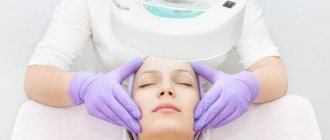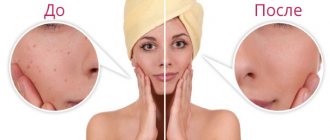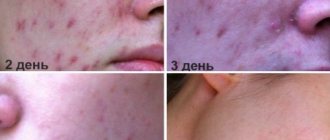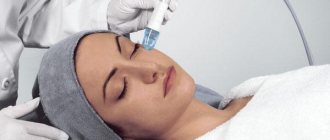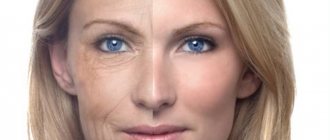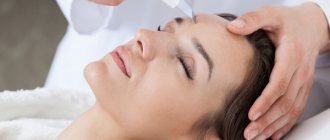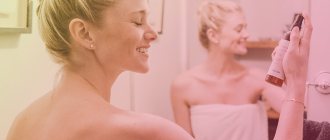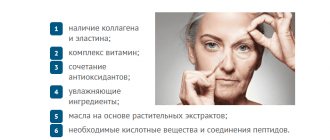The essence of the procedure
Combined cleansing is a complex effect consisting of cleansing skin impurities manually and using special devices (devices). Most often, in addition to manual techniques, peelings using ultrasound are practiced; they do not injure the skin and effectively prepare it for further processing.
As a rule, hardware cleaning is carried out to reduce swelling, eliminate the superficial stratum corneum, and reduce seasonal or age-related pigmentation. Manual cleansing is intended to treat the most problematic areas (chin, cheeks, nose) in order to eliminate fatty deposits, inflammation, deep sebaceous plugs and blackheads.
In addition to cleansing the skin, combined cleansing helps to increase the flow of oxygen to cells, mechanical micromassage and heating of soft tissues, and activates internal processes of blood circulation and lymph flow. This comprehensive effect ensures maximum results and an individual approach to each client.
How does it work
The mechanical (manual part) is first performed manually. Sometimes the cosmetologist takes special tools, if necessary. For example, a Uno spoon or a Vidal needle. Of course, before cleaning, the master talks in detail about the essence of the procedure, its sequence, and shows all the devices prepared for use. The patient can openly ask all the questions that interest him, especially if he is undergoing cleaning for the first time.
First, the skin is steamed (using steam or a special gel), this opens up the pores and makes them easier to process. At the same time, sebaceous plugs and pockets of contamination soften.
Next, after examining the face, the master treats the most contaminated, problem areas. Plugs and dirt can be easily removed manually by squeezing or using a strainer.
The sharp, second end of the spoon helps remove acne; there is a hole in the center.
The procedure is considered aggressive, because it is manual cleansing with squeezing.
Ultrasonic, the second part requires a special device that needs to be used to treat the face. First, the skin is lubricated with a special composition, then the master connects an emitter, a source of ultrasonic waves.
By applying the emitter to areas of the skin, the cosmetologist provokes high-frequency vibrations, they help to quickly separate dead cells, remove all sebaceous plugs, and work on other impurities. The power of ultrasound is selected individually each time so that the waves affect only contaminated or dead cells, without affecting healthy ones.
A special composition with which the face is lubricated before cleaning helps improve the transmission of all ultrasonic vibrations.
Ultrasound acts by performing three separate tasks:
- Physico-chemical. Cells are more fully saturated with oxygen, renewed, and immunity also increases.
- Mechanical. The effect of microvibration, similar to local micromassage, helps the cells to open up more and relax.
- Thermal. The tissues are locally heated (a little, only 2 degrees), which activates internal metabolism and lymphatic drainage.
Indications
Combined cleansing is a universal procedure suitable for comprehensive cleansing and healing of facial skin. As a rule, this kind of exposure is recommended by the patient in the following cases:
- Increased oily skin.
- Acne, pimples and milia.
- Black dots.
- Swelling.
- Decreased skin tone.
- Shallow scars.
- Enlarged pores and sebaceous plugs.
- Pale skin color and uneven structure.
The procedure is recommended for patients with oily, combination and normal skin.
Contraindications
Combined facial cleansing combines contraindications of manual and hardware techniques. Procedures of this type are prohibited when:
- Pregnancy.
- Oncology.
- Diabetes mellitus and other pathologies of the endocrine system;
- The presence of metal implants and bio-reinforcement of the face with gold threads.
- Pathologies of the heart and blood vessels.
- Hypertension.
- Bronchial asthma.
- Menses.
- Elevated body temperature.
- Severe malaise caused by exacerbations of chronic diseases.
- Violation of skin integrity.
- Inflammations, numerous moles on the skin of the face.
- Dermatological and fungal diseases.
A good cosmetologist will always pre-interview the patient and ask him leading questions to identify possible contraindications.
What goes with it?
The logical conclusion of cleaning is the peeling procedure. It involves the action of chemicals on the skin of the face (for example, peeling with lactic acid). But it is carried out precisely after the face has healed, about a week after the cleansing process.
Peeling evens out the relief of the surface of the face and removes the keratinized surface layer of the skin.
Often there is a combination of combined cleansing with facial cryomassage with liquid nitrogen, ultraphonophoresis procedure, electrophoresis, gas-liquid facial peeling and darsonvalization to enhance the effect.
Often there is a combination of combined cleansing with facial cryomassage with liquid nitrogen, ultraphonophoresis procedure, electrophoresis, gas-liquid facial peeling and darsonvalization to enhance the effect.
Algorithm
On average, combined cleaning lasts about two hours. The entire procedure can be divided into the following stages:
- Cleansing surface contaminants with preparations selected based on the patient’s skin type.
- Using a scrub to combat dead cells and optimally open pores.
- Performing manual massage to relax muscles and prepare for further effects.
- Applying gel to expand pores and prepare the skin for ultrasonic exposure.
- Ultrasonic cleaning using targeted impulses that penetrate deep into soft tissue without damaging the skin. Eliminates surface impurities, breaks up sebaceous plugs and blackheads.
- Disinfection of skin.
- Manual (manual) cleaning, designed to remove deep contaminants that cannot be affected by hardware. It is carried out by hand or using special devices (Unna spoon).
- Applying therapeutic (nourishing, moisturizing or antibacterial) masks. Exposure time is 15-20 minutes.
- Applying moisturizer.
In some cases, manual intervention precedes ultrasound therapy. In addition, the given list of manipulations can be significantly expanded through the implementation of additional procedures (facial treatment with electric current, infrared radiation, liquid nitrogen).
Video: how combined facial cleansing is carried out
Ultrasonic cleaning
Ultrasonic cleaning is an effective and safe method of removing impurities from the skin. The procedure does not injure, therefore it is suitable for dry and sensitive skin. Pre-steaming before ultrasound treatment is not required, which significantly reduces the session time and the load on the skin. Cleansing occurs through exposure to ultrasonic waves of a certain frequency and intensity for no more than 15 minutes.
When the plate of the device comes into contact with the skin, a high-frequency wave passes through it, causing the cells to vibrate. Thanks to micro-oscillations, impurities come out through the pores, after which the cosmetologist carefully removes them from the surface of the skin with a special spatula.
Benefits of ultrasonic cleaning
The advantages of ultrasonic cleaning include:
- painlessness;
- pronounced effect;
- no skin trauma;
- short-term rehabilitation period;
- no side effects such as swelling, burns, bruises, hyperpigmentation;
- cleansing and rejuvenating effect.
Ultrasonic cleaning should be carried out once a month if the skin is oily or combination, once every 3 months if the skin is dry. To achieve a lasting effect, it is recommended to carry out a course of 4-8 procedures.
Indications for ultrasonic cleaning
Indications for ultrasonic cleaning are as follows:
- comedones;
- acne;
- flabbiness;
- enlarged pores;
- decreased tone;
- the first signs of age-related changes;
- dermatitis;
- dark spots;
- keratosis.
It is also useful to perform ultrasonic cleaning to prevent aging and photoaging of the skin.
The effectiveness of ultrasonic cleaning
During the procedure, dead skin cells, sebaceous plugs, residual sebum and other impurities are removed, and pores are narrowed. Ultrasonic waves stimulate regeneration processes, improve overall resistance and tissue nutrition. After the procedure, the face looks smooth, fresh and rested. Moisturizing and soothing agents are applied to it.
Post-procedure care
There are no strict restrictions during the rehabilitation period, but on the day of cleaning it is recommended to avoid visiting the solarium, bathhouse, sauna and swimming pool. To completely restore pores, you should not apply decorative cosmetics for 24 hours. Care is carried out with regular means.
Contraindications
Ultrasonic cleaning is not performed on women during pregnancy. The procedure is also contraindicated for:
- dermatological diseases;
- facial nerve paralysis;
- oncological diseases;
- vasodilation;
- exacerbation of acne;
- infections;
- epilepsy;
- recently dry cleaned;
- the presence of metal and silicone implants.
Side effects
Temporary side effects (redness, soreness, peeling, mild swelling or swelling) may occur for 3-7 days after cleansing. The reason for their appearance is the natural reaction of the skin to the impact (pressure and trauma to the skin).
Peeling of the skin after combined facial cleansing
If recommendations for skin care after the procedure are not followed, as well as if safety precautions are violated during the procedure, in addition to side effects, more serious complications may arise that require observation or treatment. These can be inflammatory processes, scars, bruises, persistent swelling and hematomas. In rare cases, local burns from ultrasound are observed.
general information
Any cosmetic cleansing is aimed at cleansing the surface of the face from foreign formations: blackheads, pimples, acne, etc. Such manifestations on the skin occur when the sebaceous glands do not work properly. The contents of the sebaceous glands are called sebum. Normally, it performs a protective function and affects thermoregulation.
Protects against frostbite in cold weather and from ultraviolet rays in hot weather. Performs moisturizing and anxioxidant functions.
Sebum begins to be produced in large quantities in case of certain disorders in the body: hormonal, diseases of the liver, kidneys, adrenal glands and stomach.
Poor nutrition can also lead to this. These are internal reasons.
Superficial causes are manifested by infection on the skin, a reaction to cosmetics, as well as a lack of proper care for the surface of the face. You need to be able to distinguish between formations that appear on the skin of the face in order to work out an appropriate strategy for getting rid of them. Many people believe that acne and pimples are the same thing, but this is not entirely true.
Acne is the initial stage of acne, appearing as deeper formations under the skin. They occur due to excess accumulation of sebaceous oil in the pores, and are limited to the subcutaneous location. Acne is divided into wen and comedones. The former have a white surface, the latter have a black dot at the end.
Pimples are superficial inflammations that occur when acne is associated with a bacterial infection. With skin problems, entire colonies of pimples or rashes are observed, in other words, acne.
In cases of acne appearing on the face, cosmetologists rightly suggest treating the internal cause in parallel, and in adolescence - not to interfere with the processes of hormonal changes and wait it out, making do with superficial means. Any facial cleansing is the removal of the above-mentioned formations from the surface of the face.
All cosmetic cleanings are generally divided into two types: mechanical and hardware. You can clear the skin of acne on your own, but often this method is accompanied by consequences in the form of scars due to the lack of professional skills and abilities.
A cosmetologist knows all the intricacies of the process, as well as the physiological characteristics of a person, which allows him to achieve positive and most predictable results.
Rehabilitation period
As mentioned above, the rehabilitation period after cleaning lasts on average up to one week and is determined by the individual characteristics of the skin and soft tissues of each person. Immediately after the procedure, you should limit your time outside, especially in strong winds and freezing temperatures. In addition, it is recommended to refrain from:
- From washing with water - 1 day.
- From using decorative cosmetics and scrubs - 3-7 days.
- From intense physical activity leading to active sweating - 3-7 days.
- From visiting saunas and baths, solariums and beaches - up to 7 days.
It is mandatory to treat the face with gentle antiseptics; they eliminate bacteria but do not dry the skin. Also, we should not forget about regular care after complete healing of the face based on cosmetic preparations (tonics for narrowing pores, moisturizing creams). This will help maintain the results obtained at the proper level.
Existing side effects can be reduced with the help of sterile cool compresses and ointments based on plant extracts (chamomile, calendula). They remove swelling, inflammation and additionally disinfect the skin.
Duration of saving results
After combined cleansing, the skin remains smooth and healthy for 2-6 weeks. It should be noted that these figures are very arbitrary and may differ both up and down, it all depends on the oiliness of the patient’s skin, the regularity and quality of skin care.
The procedure is one-time and does not imply a course. It is extremely rare for cosmetologists to recommend 2 or 3 sessions in a row to achieve pronounced results.
Patient reviews
Reviews from the most popular resources state the following.
The first girl is very pleased with the cleaning: “I plan to repeat it in another month, since everything didn’t go away in 1 procedure. Immediately after the manipulations, the face did not look the best. To which there was a corresponding reaction from the husband and daughter at home. The husband asked at the beginning: “And you paid a tidy sum for this?!” But in the end everyone was happy.”
The second girl also failed to get rid of all the goodness in one procedure: “I took the whole course - once a month.
As the cosmetologist promised, with each new cleansing the face will get better and better. That's what happened. The face was also further smoothed out.
When the cleansing process was carried out simply by the hands of a specialist, the results were more impressive than when using third-party tools (Uno spoons). Everything greatly depends on the right choice of specialist. As a result, the pores narrowed and fine wrinkles disappeared.”
The third girl says: “I have combination skin. I underwent a combined cleansing combined with cryomassage. At the stage of mechanical manipulations, the most pain was on the chin and cheekbones. Cryomassage as the final stage was intended to relieve redness and inflammation on the skin from mechanical pressure.”
Advantages and disadvantages
The main advantage of combined cleaning is the ability to simultaneously remove all types of dirt, from superficial to the deepest and most difficult to reach. The procedure has a wide range of indications and is ideal for all patients with oily and combination skin. At the same time, it adapts well to the individual characteristics of each patient and reduces possible risks of injury.
Unfortunately, combined cleaning also has its drawbacks. Thus, leaving their negative reviews about the procedure, patients note the following weaknesses:
- Duration of exposure.
- Inability to carry out manipulations at home.
- Possibility of side effects.
- Availability of a rehabilitation period;
